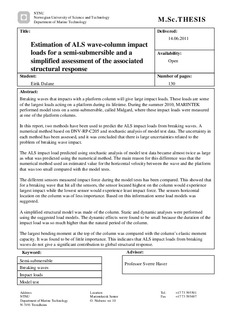| dc.contributor.author | Dalane, Eirik | nb_NO |
| dc.date.accessioned | 2014-12-19T12:06:37Z | |
| dc.date.available | 2014-12-19T12:06:37Z | |
| dc.date.created | 2012-02-08 | nb_NO |
| dc.date.issued | 2011 | nb_NO |
| dc.identifier | 492581 | nb_NO |
| dc.identifier.uri | http://hdl.handle.net/11250/237956 | |
| dc.description.abstract | Breaking waves that impacts with a platform column will give large impact loads. These loads are some of the largest loads acting on a platform during its lifetime. During the summer 2010, MARINTEK performed model tests on a semi-submersible, called Midgard, where these impact loads were measured at one of the platform columns.
In this report, two methods have been used to predict the ALS impact loads from breaking waves. A numerical method based on DNV-RP-C205 and stochastic analysis of model test data. The uncertainty in each method has been assessed, and it was concluded that there is large uncertainties related to the problem of breaking wave impact.
The ALS impact load predicted using stochastic analysis of model test data became almost twice as large as what was predicted using the numerical method. The main reason for this difference was that the numerical method used an estimated value for the horizontal velocity between the wave and the platform that was too small compared with the model tests.
The different sensors measured impact force during the model tests has been compared. This showed that for a breaking wave that hit all the sensors, the sensor located highest on the column would experience largest impact while the lowest sensor would experience least impact force. The sensors horizontal location on the column was of less importance. Based on this information some load models was suggested.
A simplified structural model was made of the column. Static and dynamic analyses were performed using the suggested load models. The dynamic effects were found to be small because the duration of the impact load was so much higher than the natural period of the column.
The largest bending moment at the top of the column was compared with the column’s elastic moment capacity. It was found to be of little importance. This indicates that ALS impact loads from breaking waves do not give a significant contribution to global structural response. | nb_NO |
| dc.language | eng | nb_NO |
| dc.publisher | Norges teknisk-naturvitenskapelige universitet, Fakultet for ingeniørvitenskap og teknologi, Institutt for marin teknikk | nb_NO |
| dc.title | Estimation of ALS wave-column impact loads for a semi-submersible and a simplified assessment of the associated structural response | nb_NO |
| dc.type | Master thesis | nb_NO |
| dc.contributor.department | Norges teknisk-naturvitenskapelige universitet, Fakultet for ingeniørvitenskap og teknologi, Institutt for marin teknikk | nb_NO |
